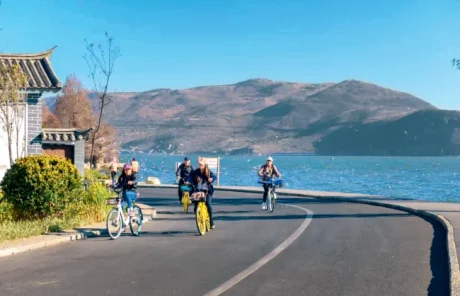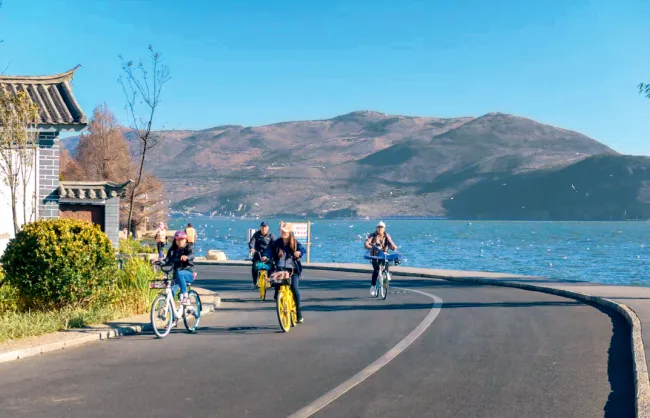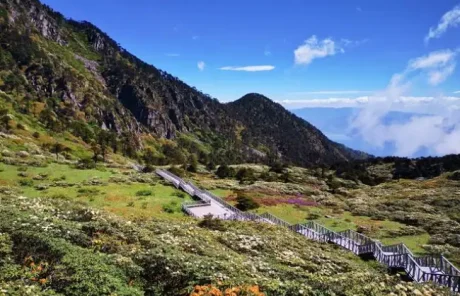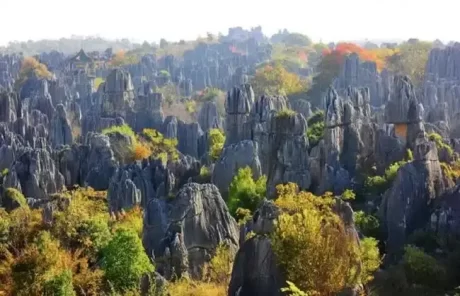Dali Travel Guide – The Ultimate Guide to Dali, Yunnan
Located in the western Yunnan Province, Dali is one of the few cities that have such a magnificent setting, hugging the shores of Erhai Lake, and surrounded by the Cangshan Mountains. With its one-of-a-kind blend of rich history, unique Bai culture, natural beauty, and peaceful vibe, Dali is always among the top three Yunnan travel destinations. No matter the season, its year-round spring-like climate means you can revel in many ancient towns and villages, and outdoor adventures in Dali any time of year.
Dali might be best known for its rich ethnic culture and historical experiences, especially the Bai ethnic features. The cobblestone streets of Dali Ancient Town are lined with Bai people’s unique residences, historical relics from the Nanzhao and Dali Kingdom periods, various handicraft shops, and restaurants representing local long-standing culinary culture.
Whether you’re into ethnic culture, historical places, leisure sightseeing, or outdoor activities, here is an ultimate travel guide to help you enjoy your next visit to Dali.

- Chinese Name: 大理(dà lǐ)
- Status: The capital of the Dali Bai Autonomous Prefecture
- Location: In the western part of Yunnan Province, China. Situated on the Erhai Plain of the Yunnan-Guizhou Plateu.
- Population:3,342,000
- Main ethnic groups: Bai, Han, Yi, Hui, and other ethnic groups; Bai people make up over 80% of its population.
- Altitude:730 – 4295 meters above sea level
- Area:1815 square kilometers
Why Visit Dali?
- Stunning natural settings: Dali sits on the shore of the impressive Erhai Lake and is surrounded by the Cangshan Mountains, offering fantastic views all year round. The rural scenery around the ancient towns adds to its unique idyllic charm.
- Rich relics and heritage: Famous historical landmarks in Dali include the eye-catching Three Pagodas from the Nanzhao and Dali Kingdom periods and Dali Ancient Town. Dali Ancient Town stands as one of the most well-preserved traditional Bai ethnic architectural complexes, and has been listed as a UNESCO World Heritage Site.
- Authentic Bai ethnic culture and customs: As the birthplace of Bai culture, Dali is home to a large Bai population who well-preserved their traditional architecture, costume, folk music and dance, cuisine, and many intangible cultural heritage. A Dali tour allows you to deeply experience all of these treasures.
- Dali is where you can escape the bustling city life. Here you can wander through the narrow cobblestone streets of Dali Ancient City, stop at a teahouse to try the Three-course Tea, bike around Erhai, or enjoy a leisure hike in Cangshan. The city canlet you truly unwind in peaceful surroundings.

Visiting Dali is a journey filled with rich historical landmarks and stunning natural beauties. The city always carries with it a fascinating mix of historical buildings, unique cultural experiences, and awe-inspiring natural attractions.
By joining a Dali Yunnan tour, you can explore many vibrant ancient towns and villages, immerse in the allure of Bai culture, marvel at the stunning harmony of Cangshan Mountain and Erhai Lake, and witness the architectural mastery of Three Pagodas of Chongsheng Temple…
See below the must do attractions in Dali to discover its essence.
Butterfly Spring
Each spring, the Butterfly Spring will become a gathering place of thousands of colorful butterflies, attracting many tourists. The spring is associated with a touching legend of a Bai couple, which alongside the surrounding beautiful natural scenery adds to its romantic ambiance.
Top Things to Do in Dali
Leisurely Stroll in Dali Ancient City Day and Night
Dali Ancient City is dominated by lines of traditional Bai architecture, historical buildings and temples, and shops offering various handicrafts and delicacies, which all breathe soul and history into the city. Take a stroll through the town’s bluestone paved streets, you’ll find each of the antique streets hosts some of its treasures. The night of the ancient town is even more lively, being teemed with local foods, handmade crafts, and vibrant Bai ethnic song and dance performances.
Bike around Erhai Lake
Cycling around Erhai Lake is one of the top activities to deeply feel the charm of Dali. Spanning around 120-130 kilometers, this cycle route leads you into a peaceful haven, with stunning views of the shimmering lake, distant Cangshan Mountain, and the scattered ancient villages along the lake shore.
The pace of the cycling trip is entirely up to you. Based on your interests, you can visit any village during the cycling, and experience the local Bai ethnic group’s life and cuisine. Or, pause at any spot to capture the breathtaking landscapes.

Learn Tie-dye in Zhoucheng Village
As one of the largest Bai ethnic villages in China, one thing that Zhoucheng is remarkable for is its traditional tie-dyeing craftsmanship. This ancient technique has been deeply rooted in its culture, resulting in the various workshops here. During the hands-on experience, typically, visitors will follow the guidance of a local artisan, learning to use tools like ropes, or cotton threads to fold or twist the fabric into different shapes before dipping it into natural plant-based dyes. It should be a great chance to deeply understand the beauty of a time-honored craft.
Savor Authentic Bai Cuisine
Besides visual feasts and cultural immersion experiences, Dali will also entertain visitors with a feast for taste buds given its diverse Bai cuisine. You can start your day with a taste of the traditional Three-course Tea. Any hidden alley in the ancient town hosts great Bai restaurants serving signature dishes of the Bai ethnic group.
Sour and Spicy Fish is known for its tender texture and distinct sauce. Rushan (a type of grilled cheese) is cherished for its delightful combination of crispy and tender textures. Xizhou Baba (a kind of pancake) is a popular breakfast treat with its golden, crispy exterior and sweet or savory filling.
More popular Dali delicacies include Shaguo Yu (clay pot fish), Carved Plum Pork ( slices of pork belly paired with plums), and Liangji Mixian (cold chicken rice noodles).
Important Bai Ethnic Festivals in Dali
Listed below are some major festivals of the Bai ethnic group, showcasing not only their traditional customs but also religious beliefs. Plan your trip to Dali according to their dates if you are interested in these festivals.
San Yue Jie (三月街) ( March Street Festival / Guanyin Festival)
- Date: Annually from the 15th to the 20th day of the third lunar month
- Location: Outside the West Gate of Dali Ancient City
- Features: Aka the March Street Ethnic Festival or Guanyin Market, San Yue Jie is the grandest festival of the Bai ethnic group. During the festival, markets are set up along the laneways, various local featured activities like horse racing, dragon boat racing, and swinging are held, and diverse traditional performances are also featured.
Torch Festival (火把节)
- Date: The 25thday of the sixth lunar month, lasts for three days
- Features: The Torch Festival of the Bai ethnic group is a little different from the Yi ethnic group on both dates and celebrations. Originating from people’s worship of fire in the ancient time, the festival just revolves around the elements of fire. During the festival, each family will light a small torch on their gate, and each village will erect a large torch in the village square. At dusk, they will light the torch, dancing around the torch to pray for good harvest and health.
Rao San Ling (绕三灵)
- Date: from the 23rd to the 25th day of the fourth lunar month
- Features: An important religious activity of the Bai ethnic group, Rao San Ling originated from their ancient religious ritual. San Ling refers to three significant temples in Dali: Shengyuan Temple, Jinkui Temple, and Chongsheng Temple. During the festival, Bai people will dress in traditional attire, process around the three religious sites, and perform various dances and joyful singing.
Dali Weather & Best Time to Visit
Located in western Yunnan Province, Dali’s low latitude and high altitude combine to create its low-latitude plateau monsoon climate. This results in a mild climate year-round, with the annual average temperature ranging around 15-17°C. Typically, the city sees small seasonal temperature differences, but distinct wet seasons (late May to September) and dry seasons (October to April).
The best time to visit Dali is from March to May and September to November when Dali’s weather provides an ideal setting to discover its ancient towns and is perfect for outdoor activities.
March to May is pleasant with blooming blossoms and is the time to host several ethnic festivals, like San Yue Jie.
September to November is the time when the city’s autumn colors start to appear. The golden fields and colorful leaves among Cangshan Mountain together create a beautiful visual spectacle.

Dali Transportation: How to Get to & Travel Around
How to Get to Dali?
Dali Fengyi Airport, about 13 kilometers from Dali city center, is the main airport serving the city. Currently, it offers many direct domestic flights to/from major cities, like Beijing, Shanghai, Guangzhou, Shenzhen, and Chengdu. There are airport shuttle buses to reach Dali Ancient City directly, taking about 1 hour for a single trip. A taxi ride from the airport to the old town is about 45 minutes and CNY 90.
Direct high-speed trains also provide a comfortable and fast travel option to reach Dali. Dali Railway Station offers direct bullet or high-speed trains to Kunming, Chongqing, Guiyang, Chengdu, etc. Many visitors choose to fly to Kunming first before they transfer a high-speed train from Kunming to Dali.
How to Travel Around?
Traveling around Dali city area and its surrounding attractions is easy thanks to its well-developed transportation system. It offers various bus lines running throughout the city. There are direct buses from Dali city center to Dali Old Town, and from Dali Ancient Town to Shaxi Ancient Town.
Taxis in the city are also readily available for convenient transfers between different attractions. In some remote areas, taxis may not use the meter, so always remember to confirm the fare in advance.
The ancient towns in Dali are very pedestrian-friendly. You can explore these ancient towns on foot and enjoy a close view of the cultural treasures. Biking is preferred when traveling around Erhai Lake.
Where to Stay in Dali? Best Areas for Your Hotel and Accommodation
If you are unsure about which area or district to stay in while traveling in Dali, the following list give you a hand. The advantages of each area are also included.
Dali Ancient Town:
- Accommodation types: Guesthouses and inns converted from historic homes, boutique guesthouses, high-end/luxury hotels, and mid-range hotels.
- Why choose: Allows close access to many cultural and historical heritage and relics; multiple options for dining, entertainment, and nightlife; suitable for those who enjoy bars.
Xiaguan (Dali new city area)
- Accommodation types: Multiple star-rated hotels, business hotels, high-end resorts
- Why choose: Convenient transportation, easy to reach Erhai Lake, and easy access to daily needs.
Caicun / Shuanglang Villages
- Accommodation types: Guesthouses with rooms facing Erhai Lake, uniquely designed boutique hotels, and family-run guesthouses.
- Why choose: Caicun is on the western shore of Erhai Lake, and Shuanglang is on the eastern shore, offering stunning lake views; with diverse dining and entertainment facilities.
At the Foot of Cangshan Mountains
- Accommodation types: Resort Hotesl and rural guesthouses
- Why choose: Quiet environment, stunning natural view
How to Plan a Dali Tour
When planning a trip to Dali, it is generally recommended to plan for 3 to 6 days to explore its major attractions at a relaxed pace.
3 days is a proper duration to cover its iconic sights, such as Dali Old Town, Erhai Lake, Three Pagodas of Chongsheng Temple, and Cangshan Mountain.
5 to 6 days is an ideal timeframe for people who want a more in-depth experience. You can add Shaxi Ancient Town, Zhoucheng Village, and Xizhou Ancient Town to your Dali trip to experience the historic Tea Horse Road and Bai tie-dyeing craft.
Indeed, most travelers don’t seek Dali as a standalone destination but intend to combine their Yunnan travel with more destinations, such as Kunming, Lijiang, and Shangri-La. Visitors can easily take a bus or train to transfer between Dali and these popular places.
Recommended Yunnan Tours including Dali:
Other Popular Destinations in Yunnan










